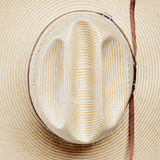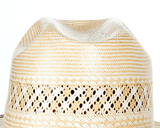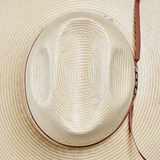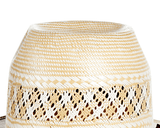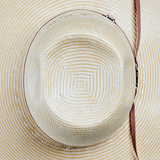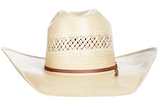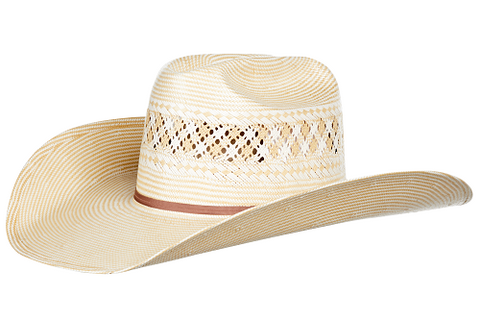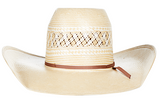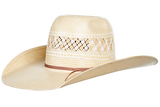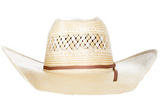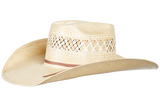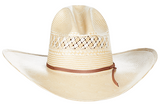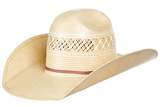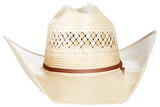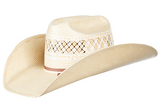Table of Contents
-
Introduction to Cowboy Hats
-
The Historical Roots of Cowboy Hats
-
Cowboy Hat Etiquette
-
Seasonality: Felt vs. Straw Cowboy Hats
-
Cleaning and Maintenance
-
Open Crown vs. Pre-Creased Cowboy Hats
-
Cowboy Hat Shape Options
-
Popular Brands Overview
-
Conclusion
Introduction to Cowboy Hats
Welcome to "The Essential Guide to Cowboy Hats," where we dive deep into the world of one of the most iconic and enduring symbols of Western culture. The cowboy hat, more than just a piece of headwear, is a symbol of history, heritage, and personal style. It transcends its practical origins to become a quintessential emblem of rugged individualism and outdoor spirit.
Cowboy hats have long been associated with the mystique of the Wild West. They evoke images of cattle drives, open plains, and the daring spirit of early American settlers. However, their appeal isn't confined to the dusty trails of history. Today, cowboy hats have carved out a significant niche in the fashion world, adopted by celebrities, fashion enthusiasts, and people who appreciate their blend of function and style.
In this blog, we will explore the rich tapestry that makes the cowboy hat not just an accessory, but a statement. From the dusty arenas of rodeos to the high-end fashion runways, cowboy hats have proven their versatility and timelessness. We will look at their origins, the evolution of styles and materials, and how they have been adapted and reinterpreted in modern fashion.
Whether you're a cowboy hat aficionado or new to this iconic headwear, this guide will offer insights, tips, and a deeper appreciation for the cowboy hat's unique place in both history and contemporary style.
The Historical Roots of Cowboy Hats:
From Function to Fashion
The cowboy hat, an unmistakable icon of Western attire, has roots that run deep in American history, stretching back to the late 19th century. Its inception is often attributed to John B. Stetson, who crafted the first hat of this kind in the 1860s. The original design, known as the "Boss of the Plains," was pragmatic—a wide-brimmed, high-crowned hat made from felted beaver fur, designed to protect cowboys from the harsh elements of the American West. Its wide brim shielded eyes from the glaring sun and offered some protection against rain, while its high crown provided insulation.
As cowboys herded cattle across vast territories, the cowboy hat became an indispensable part of their attire, designed for durability and functionality. The material and shape were ideal for the fluctuating weather conditions, from the scorching heat to unexpected downpours. However, the journey of the cowboy hat from a functional piece to a fashion statement is a testament to its versatility and enduring appeal. In the early 20th century, with the rise of Western movies, these hats began to symbolize the rugged, independent spirit of the American cowboy. Hollywood played a pivotal role in cementing the cowboy hat's iconic status, with movie stars donning these hats and bringing the cowboy image to audiences worldwide.
Over time, the cowboy hat evolved in style and material, branching out from its original design to various shapes and colors, reflecting both personal style and cultural trends. Today, it transcends its utilitarian roots, worn not just by cowboys but by people from all walks of life as a symbol of American heritage and timeless fashion.
Cowboy Hat Etiquette:
Wearing and Handling with Respect
Cowboy hats are more than just a fashion statement; they come with a set of traditions and etiquettes that reflect respect and good manners. Understanding and adhering to these unwritten rules is crucial for anyone looking to don this iconic headwear.
-
Indoors vs. Outdoors: Traditional cowboy hat etiquette dictates removing your hat when indoors, especially in restaurants, homes, and public buildings. This shows respect for the environment and the people around you. However, modern cowboy hat etiquette has adapted to only require removal in church, at dinner, and during the national anthem at rodeos and sporting events.
-
Handling the Hat: Always handle your cowboy hat by the crown, not the brim. Grabbing the brim can misshape the hat over time. To maintain its form, it's recommended to pick it up and put it down by the crown. Alternatively, when placing your cowboy on a surface, it is best to place it on its crown with the bottom of the brim facing up.
-
Tipping or Touching: Tipping your hat is a sign of acknowledgement or greeting, especially in rural or Southern areas. A slight tip of the brim to strangers or a small lift of the hat to friends is a gesture of politeness.
-
Proper Fit and Position: The hat should fit snugly on your head, ensuring it won’t easily blow away in the wind. Traditionally, the hat is worn straight across the forehead and ears. However, personal style can dictate how far back it sits.
By following these simple guidelines, you can wear your properly fitting cowboy hat with the respect and tradition it deserves, whether you’re at a rodeo, a concert, wedding, or just enjoying a day out.
Seasonality: Felt vs. Straw Cowboy Hats
In the diverse world of cowboy hats, the choice of material plays a crucial role in both function and style, particularly when it comes to adapting to different seasons.
Felt cowboy hats, typically worn October through March and made from wool or fur blends, are favored in these colder months due to their insulating properties. The dense, tightly woven fabric of felt provides substantial warmth, making it an ideal choice for winter wear. Additionally, felt hats are known for their durability and water-resistant qualities, offering protection against snow and rain, which is essential in harsher weather conditions.
Straw cowboy hats are the go-to choice during the warmer months of April through September. Made from lightweight, breathable materials like raffia, straw, or palm, these hats are designed to offer comfort and ventilation in hot weather. The looser weave allows for air circulation, keeping the head cool, while the wide brim offers ample shade from the sun, making them perfect for outdoor activities like rodeos, festivals, or casual wear.
Both materials have their unique advantages. Felt hats offer a classic, polished look and are incredibly resilient, often lasting for years with proper care. Straw hats, with their relaxed and airy feel, provide a casual, laid-back aesthetic, ideal for summer outings. Each material, be it felt or straw, contributes to the cowboy hat’s enduring appeal, blending practicality with style to suit various climates and occasions.
Cleaning and Maintaining Cowboy Hats:
A Step-by-Step Guide
Felt Cowboy Hats:
-
Dust Removal: Begin by gently brushing your felt hat with a soft-bristled brush. Brush counterclockwise to remove surface dust and dirt.
-
Spot Cleaning: For stains, use a clean, damp cloth. Gently dab the stained area; avoid rubbing to prevent the felt from matting.
-
Drying: If the hat gets wet, let it air dry naturally. Avoid using a hair dryer or direct heat, as this can cause the felt to shrink or warp.
Straw Cowboy Hats:
-
Dust Removal: Use a clean, dry cloth or a soft brush to wipe away dust. Brush gently to avoid damaging the straw.
-
Wiping Down: For light stains, lightly dampen a cloth with water and gently wipe the affected area.
-
Drying: Allow the hat to air dry completely before storing. Never expose straw hats to high heat or direct sunlight when wet.
Tips for Storage and Maintaining Shape:
- Store both felt and straw hats in a cool, dry place away from direct sunlight.
- Use a hat rack or a form to maintain the hat’s shape. Avoid laying the hat flat or hanging it by the brim, as this can cause deformation.
- For short-term storage, NRS World offers a range of plastic cowboy hat cans that are ideal for maintaining the shape and protecting from damage.
View NRSWorld's collection of cowboy hat cleaning and storage solutions to ensure that your cowboy hats, whether felt or straw, remain clean and well-maintained, preserving their shape and appearance for years to come.
Open Crown vs. Pre-Creased Cowboy Hats
In the realm of cowboy hats, the distinction between open crown and pre-creased styles represents not just a difference in appearance, but also a choice in personal expression and tradition. Open crown cowboy hats, as the name suggests, come with a smooth, uninterrupted crown, offering a blank canvas for individual styling. This style harkens back to the old days of the West, where cowboys would shape their hats according to personal preference or practical need, giving each hat a unique character reflective of its wearer. The in-house hat bar at NRS World (National Roper's Supply) stores captures the essence of this personalized tradition. Here, the romantic allure of the Old West meets contemporary craftsmanship. Customers can watch as their open crown hats are transformed into custom, hand-creased masterpieces. Each crease, fold, and bend is meticulously crafted, turning a simple piece of headwear into a personal statement. This experience not only celebrates the rich history of cowboy hats but also empowers individuals to have a hand in shaping their legacy, one hat at a time. Visit one of our stores today to see our artisan hat shapers at work, read on to view more about cowboy hat shapes, or view our
Cowboy Hat Creases Informational Page.
Cowboy Hat Shapes & Creases
Cowboy Hat Crown Options at NRS
Cattleman:
- Style: "The Gentleman's Crease"
- Description: Deep center crease with one mid-sized crease on each side.
- Crown Height: 4 1/2" to 5"
- Origin: Preferred by ranch owners to distinguish from rodeo cowboys; popular among team ropers.
Minick:
- Style: "Jack of All Trades, Master of None"
- Description: Shallow center crease with a small dent on each side.
- Crown Height: 5 1/2"
- Origin: Named after legendary cowboy Billy Bob Minick.
Brick:
- Style: "The Canadian Crease"
- Description: Squared middle crease with one mid-sized crease on each side.
- Crown Height: 4 1/4" to 4 1/2"
- Origin: Adapted from the Cattleman, featuring a more square look.
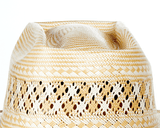

Cool Hand Luke:
- Style: "The OG Roughie Crease"
- Description: Oval dent in the top with one small dent on each side.
- Crown Height: 5 1/2" to 5 3/4"
- Origin: Popularized by PBR World Champion Luke Snyder.
West Texas Punch:
- Style: "The Super Puncher Crease"
- Description: Two large dents, one on each side of the crown.
- Crown Height: Approximately 6"
- Origin: Favored by cowpunchers in West Texas.
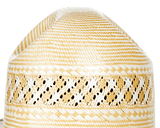

Walker:
- Style: "Seen At Train Stations Near You"
- Description: Open crown with a small dent on each side.
- Crown Height: Approximately 6"
- Origin: Popularized by the character Walker from "Yellowstone."
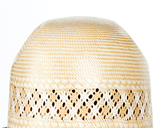
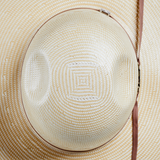
Gus:
- Style: "The Old West Original Crease"
- Description: Dent on each side following the main center crease, with a sloped crown.
- Crown Height: Approximately 2 3/4" in front, increasing at the back.
- Origin: Named after Augustus McCrae from "Lonesome Dove."


Teardrop:
- Style: "The Pinch Front Crease"
- Description: Deep V-shaped crease on the top, center popped up, with dimples on each side of the front.
- Crown Height: Usually 4 1/2"
- Origin: Popular for fedora style hats.


Cowboy Hat Brim Options:
JB: Front brim wider than the crown, straight front with soft corners, medium side height.
J (George Strait): Front brim same width as the crown, soft corners, medium side height.
Cool Hand Luke: Widest front brim, square front, low side height.
U: Wide front brim with higher sides, tighter back, square front, soft "U" in the back.
Round: Classic round brim, soft crease, gradual drop.
West Texas Punch: Front width wider than the crown, tight "U" in the back, straight front, tall side height.
Showmanship: Front brim width inside crown width, sharp corners, high and tight sides.
Choosing the right cowboy hat shape for your face and personal style involves considering both the shape of your face and your individual fashion sense. Here are key points to keep in mind:
Face Shape:
-
Oval Faces: Almost any hat shape works well. A balanced crown height and brim width, like the Cattleman, can complement this face shape.
-
Round Faces: Opt for hats with high crowns and wide brims to elongate the face, such as the Gus or Brick crease.
-
Square Faces: Rounder, softer hat shapes like the Minick or Teardrop can soften the angular features.
-
Long Faces: Choose hats with medium to low crown heights and wider brims, like the West Texas Punch, to create a sense of balance.
Personal Style:
-
Traditional: Classic styles like the Cattleman or Gus suit a more traditional Western look.
-
Modern: Contemporary shapes like the Cool Hand Luke or Walker offer a modern twist to the cowboy hat.
-
Unique: For a distinctive look, consider unique shapes like the Brick or Teardrop.
Functionality: Consider the hat's purpose. For outdoor activities, practicality may be more important, while fashion-forward styles are better suited for social events.
Comfort and Fit: No matter the style, ensure the hat fits well and feels comfortable. A well-fitting cowboy hat should be snug but not too tight.
To accurately size your head for a cowboy hat, follow these steps:
-
Measure Your Head: Use a flexible measuring tape. Wrap it around your head approximately 1/2 inch above your ears and across your forehead, where the hat will rest. Ensure the tape is snug but not too tight. For the most accurate measurement, measure your head in centimeters, as hat sizes are often marked this way.
-
Consult a Sizing Chart: Once you have your measurement, compare it to a cowboy hat sizing chart. Hats are typically sized using fractions and range from 6 ½ to 8, increasing every one-eighth to one-quarter with specific standard head circumference measurements (in inches) corresponding to each size.
-
Consider Shape and Fit: Remember that head shapes can vary, and so can hat shapes. Some people might have a longer, oval-shaped head, while others have a rounder shape. Try different styles to see which shape fits your head comfortably.
-
Adjustments and Comfort: If a hat feels too tight or too loose, check if it has an adjustable band inside. Some hats can be stretched slightly for a better fit, but be cautious not to alter the shape or damage the material.
-
Final Check: The hat should sit comfortably on your head without leaving red marks or feeling too loose. It should stay in place without sliding down over your ears or forehead.
By carefully measuring and trying on different styles, you can find the perfect cowboy hat that fits well and feels comfortable.
In summary, choosing the right cowboy hat involves balancing face shape considerations with personal style and the hat’s intended use, ensuring proper fit, aesthetic appeal and comfort.
How to Style a Cowboy Hat
As a fashion staple, the cowboy hat offers incredible versatility, effortlessly complementing a wide range of outfits for a standout look. Traditionally sported by ranchers and cowboys, these hats go well with classic t-shirts and button-up shirts. Complete this timeless style with a pair of blue jeans and quality
cowboy boots for a polished appearance. For women, cowboy hats can be paired with an array of attire, from elegant wedding dresses to chic blouses, showcasing their endless styling possibilities!
Popular Brands Overview
American Hat Company: Founded in 1915 by Sam Silver, American Hat Company has a rich history in hat making. Known for pioneering innovations in straw hat manufacturing, they offer a range of high-quality cowboy hats. Their products are celebrated for their durability and the unique process of waterproofing and fire-resistant treatments. A standout feature is their customizable brim and crown shapes, catering to personal style preferences.
Resistol: Established in 1927, Resistol quickly became a leader in the cowboy hat industry. The brand name, a contraction of "resist-all weather," reflects their commitment to producing durable, all-weather hats. Known for their "Self-Conforming" hatband and "Kitten Finish" felt hats, Resistol offers a wide range of both felt and straw cowboy hats, popular among rodeo professionals and Western enthusiasts alike.
Stetson: Founded by John B. Stetson in 1865, Stetson is synonymous with the cowboy hat itself. Their iconic "Boss of the Plains" model revolutionized Western headwear. Stetson hats are renowned for their quality craftsmanship, classic styles, and durable materials. They offer a diverse range of products, including the stylish "Tom Mix" and "Open Road" models, appealing to both traditional Western wearers and modern fashion enthusiasts.
Rodeo King: Rodeo King, in business since the 1920s, provides affordable yet quality cowboy hats. Catering primarily to the rodeo market, their hats are known for their comfort and durability. They offer a variety of styles, from classic Western to more contemporary designs, making them a popular choice for both competitive rodeo participants and casual wearers.
Buying a hat online:
At
NRSworld.com, we pride ourselves on being the best place to buy a hand-shaped cowboy hat online. We offer free hat shaping from our experts—choose from our range of crown and brim shape options for a custom fit, as well as everyday free shipping on cowboy hats. We’ve perfected the shipping process for cowboy hats, ensuring that your custom-shaped cowboy hat arrives to you exactly as specified.
Conclusion
Cowboy hats have transcended their functional origins to become enduring symbols of Western heritage and fashion, representing a blend of rugged individualism and timeless style. In both high fashion and popular culture, they embody a unique Americana spirit, resonating across various demographics and geographical boundaries. When choosing and caring for a cowboy hat, it's essential to consider personal style, face shape, and the hat's material, ensuring a choice that's not only aesthetically pleasing but also well-maintained for lasting significance and wear.


